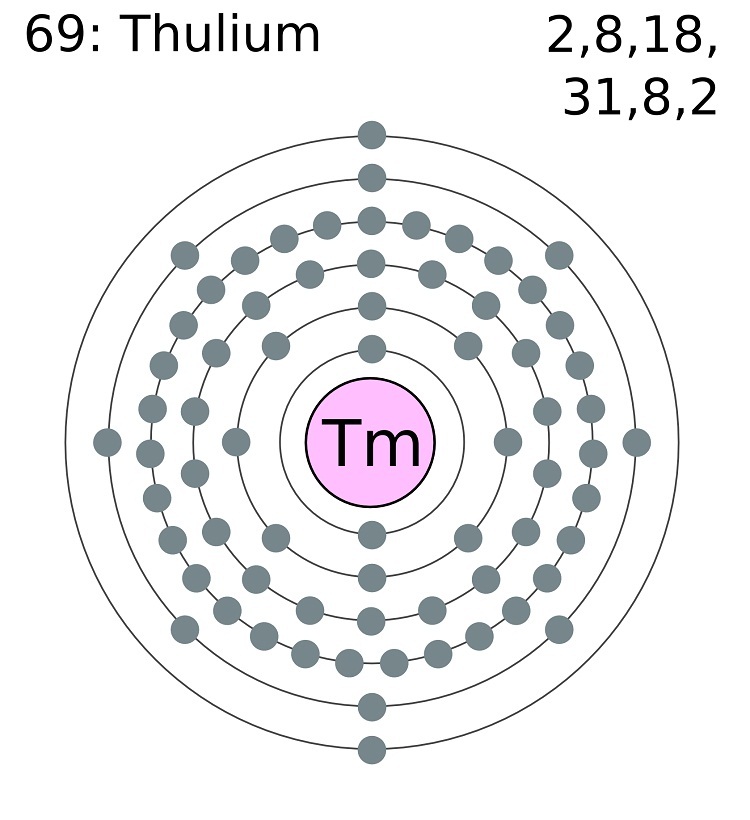Math Is Fun Forum
You are not logged in.
- Topics: Active | Unanswered
- Index
- » Science HQ
- » Thulium
Pages: 1
#1 Yesterday 17:14:38
- Jai Ganesh
- Administrator

- Registered: 2005-06-28
- Posts: 51,527
Thulium
Thulium
Gist
Thulium (Tm) is a silvery-gray, soft, rare-earth metal belonging to the lanthanide series, with the atomic number 69. It's named after Thule, an ancient name for Scandinavia. While it's the second-least abundant lanthanide, its unique properties make it valuable for high-tech applications, including medical lasers and portable X-ray units, and it is used in ceramic magnetic materials for microwaves.
Thulium is used in portable X-ray devices as a radiation source, in the production of solid-state lasers for surgical applications, and in ceramic magnetic materials (ferrites) for microwave equipment. It is also used in personal dosimeters for radiation monitoring due to its fluorescent properties.
Summary
Thulium is a chemical element; it has symbol Tm and atomic number 69. It is the thirteenth element in the lanthanide series of metals. It is the second-least abundant lanthanide in the Earth's crust, after radioactively unstable promethium. It is an easily workable metal with a bright silvery-gray luster. It is fairly soft and slowly tarnishes in air. Despite its high price and rarity, thulium is used as a dopant in solid-state lasers, and as the radiation source in some portable X-ray devices. It has no significant biological role and is not particularly toxic.
In 1879, the Swedish chemist Per Teodor Cleve separated two previously unknown components, which he called holmia and thulia, from the rare-earth mineral erbia; these were the oxides of holmium and thulium, respectively. His example of thulium oxide contained impurities of ytterbium oxide. A relatively pure sample of thulium oxide was first obtained in 1911. The metal itself was first obtained in 1936 by Wilhelm Klemm and Heinrich Bommer.
Like the other lanthanides, its most common oxidation state is +3, seen in its oxide, halides and other compounds. In aqueous solution, like compounds of other late lanthanides, soluble thulium compounds form coordination complexes with nine water molecules.
Details
Thulium (Tm) is a chemical element, a rare-earth metal of the lanthanide series of the periodic table.
Thulium is a moderately hard, silvery white metal that is stable in air but can easily be dissolved in diluted acids—except hydrofluoric acid (HF), in which an insoluble trifluoride (TmF3) layer forms on the surface of the metal, impeding further chemical reaction. Thulium is a strong paramagnet above 56 K (−217 °C, or −359 °F). Between 56 and 32 K (−241 °C, or −402 °F) the metal is antiferromagnetic with a sinusoidally modulated magnetic structure along the c-axis of its crystal structure, and below 32 K thulium is ferrimagnetic.
Thulium was discovered in 1879, along with holmium, by Per Teodor Cleve, who named the oxide thulia after an ancient name for Scandinavia. It is found in small amounts in such rare-earth minerals as laterite ionic clays, xenotime, and euxenite and in products of nuclear fission. Thulium is one of the rarest of the rare-earth elements. Its abundance in Earth’s crust is nearly the same as those of antimony and iodine.
Natural thulium is wholly composed of the stable isotope thulium-169. Thirty-five radioactive isotopes (excluding nuclear isomers) are known. They range in mass from 144 to 179, and their half-lives range from more than 300 nanoseconds (thulium-178) to 1.92 years (thulium-171). Bombarded by neutrons, natural thulium becomes radioactive thulium-170 (128.6-day half-life), which ejects soft gamma radiation with wavelength commensurate with laboratory hard X-ray sources. Only one allotropic (structural) form is known for thulium. The element adopts a close-packed hexagonal structure with a = 3.5375 Å and c = 5.5540 Å at room temperature.
Commercial production involves solvent-solvent extraction or ion exchange from monazite. The metal is prepared by reduction of its oxide by lanthanum metal followed by distillation of the thulium metal. Thulium has little practical use beyond research. Thulium-170 is used in small portable X-ray sources suitable for medical X-ray imaging and nondestructive evaluation of thin-walled structures. Together with yttrium, thulium is a component of some high-temperature superconducting oxides. The element is also employed as a dopant in yttrium-aluminum garnet for laser applications.
Thulium can be prepared in the +2 oxidation state, as in the dark-coloured diiodide TmI2. The Tm2+ ion is not stable in water; it momentarily gives a violet-red colour before being oxidized to the predominant +3 state. Thulium in the stable +3 state forms a series of pale green salts.
Element Properties
atomic number : 69
atomic weight : 168.93421
melting point : 1,545 °C (2,813 °F)
boiling point : 1,950 °C (3,542 °F)
specific gravity : 9.321 (at 24 °C, or 75 °F)
oxidation states : +2 (unstable), +3 (stable).
Additional Information:
Appearance
A bright, silvery metal.
Uses
When irradiated in a nuclear reactor, thulium produces an isotope that emits x-rays. A ‘button’ of this isotope is used to make a lightweight, portable x-ray machine for medical use. Thulium is used in lasers with surgical applications.
Biological role
Thulium has no known biological role. It is non-toxic.
Natural abundance
Thulium is found principally in the mineral monazite, which contains about 20 parts per million. It is extracted by ion exchange and solvent extraction. The metal is obtained by reducing the anhydrous fluoride with calcium, or reducing the oxide with lanthanum.

It appears to me that if one wants to make progress in mathematics, one should study the masters and not the pupils. - Niels Henrik Abel.
Nothing is better than reading and gaining more and more knowledge - Stephen William Hawking.
Offline
Pages: 1
- Index
- » Science HQ
- » Thulium